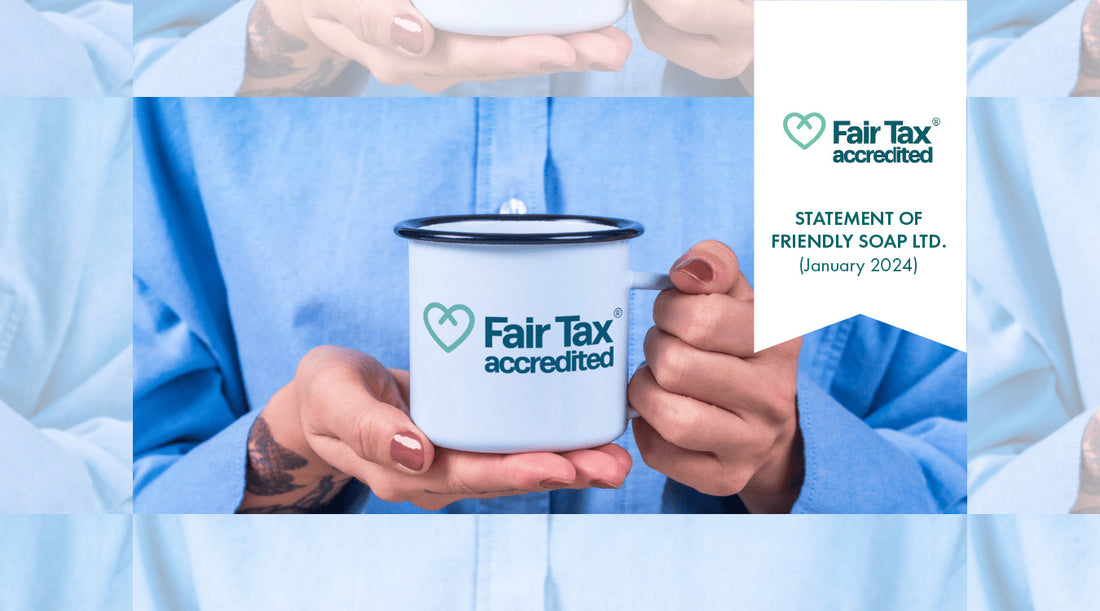Fair Tax Mark Statement of Friendly Soap Limited (January 2024)
This statement of Fair Tax compliance was compiled in partnership with the Fair Tax Foundation (“FTF”) and certifies that Friendly Soap Limited (“the Company”) meets the standards and requirements of the FTF’s Solely UK-based Business Standard for the Fair Tax Mark certification.
Tax Policy
The Company is committed to paying all the taxes that we owe in accordance with the spirit of all tax laws that apply to our operations. We believe that paying our taxes in this way is the clearest indication we can give of being responsible participants in society. We will fulfil our commitment to paying the appropriate taxes that we owe by seeking to pay the right amount of tax, in the right place, and at the right time. We aim to do this by ensuring that we report our tax affairs in ways that reflect the economic reality of the transactions that we undertake during the course of our trade.
We will not seek to use those options made available in tax law, or the allowances and reliefs that it provides, in ways that are contrary to the spirit of the law. Nor will we undertake specific transactions with the sole or main aim of securing tax advantages that would otherwise not be available to us based on the reality of the trade that we undertake. The Company will never undertake transactions that would require notification to HM Revenue & Customs under the Disclosure of Tax Avoidance Schemes Regulations or participate in any arrangement to which it might be reasonably anticipated that the UK’s General Anti-Abuse Rule might apply.
We believe tax havens undermine the UK’s tax system. As a result, whilst we may trade with customers and suppliers genuinely located in places considered to be tax havens, we will not make use of those places to secure a tax advantage, and nor will we take advantage of the secrecy that many such jurisdictions provide for transactions recorded within them. Our accounts will be prepared in compliance with this policy and will seek to provide all the information that users, including HM Revenue & Customs, might need to properly appraise our tax position.
Company Information
The Company is a private company limited by shares, originally established in 1996 for the purpose of creating and retailing natural soap products to the public from an ethical and environmentally friendly standpoint. The Company’s retailed soaps and cosmetics are vegan, cruelty-free, plastic-free and made by staff who are paid a living wage.
The Company is owned and controlled by its two directors: Geoffrey Kerouac; and Robin Costello, who each own 50% of the issued share capital and voting rights.
The Company’s registered address is: Unit 6C, Topland Country Business Park, Cragg Vale, Hebden Bridge, West Yorkshire, HX7 5RW – which is also its trading address.
Tax Information
Our profit before tax for the year ended 31 March 2023 was £221,099 (2022: £362,223). The expected tax charge on this profit at the UK headline rate of 19% would be £42,009 (2022: £68,822). Our actual current tax charge for the year ended 31 March 2023 was £43,954(2022: £70,761) at a rate of 19.9% (2022: 19.5%); and the reasons for this being more than expected is explained below in the following tax reconciliation and accompanying footnotes:
|
|
31 MARCH 2023 £ |
31 MARCH 2022 £ |
| Turnover | 1,628,834 | 1,840,285 |
| Cost of sales | (589,936) | (695,496) |
| Gross Profit | 1,038,898 | 1,144,789 |
| Other Income | 1,478 | 11 |
| Administrative expenses | (808,450) | (774,536) |
| Interest expenses | (10,827) | (8,041) |
| Profit before tax | 221,099 | 362,223 |
| Expected tax charge (19.0%) | 42,009 | 68,822 |
| * Expenses not deductible for tax purposes | 155 | - |
| ** Depreciation in excess of capital allowances | 2,248 | 2,348 |
| *** Capital allowances super-deduction | (458) | (409) |
| Actual current tax charge (19.9%) | 43,954 | 70,761 |
| Movements in deferred tax | 7,485 | - |
| Total tax charge | 51,439 | 70,761 |
As at 31 March 2023, the Company had a deferred tax liability of £7,485(2022: £Nil) on its Balance Sheet, after debiting £7,485(2022: £Nil) to its Profit and Loss account.
This deferred tax liability is in relation to temporary timing differences between the net book value of qualifying tangible assets in the accounts and their equivalent tax written down values (see footnote
2). The provision will unfold in annual instalments over the useful economic lives of the assets to which it relates.
Transactions with Directors
For the year ended 31 March 2023, the total directors’ remuneration expense amounted to £113,000 (2022: £73,140). Directors’ remuneration consists of gross salary and pension contributions.

